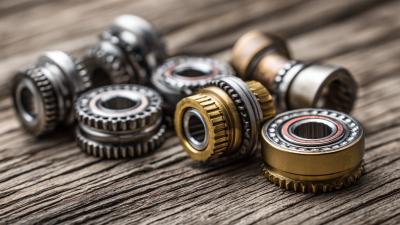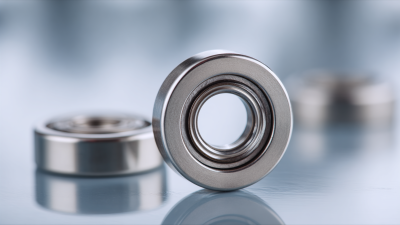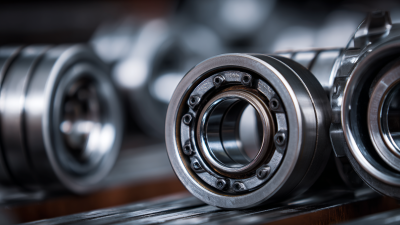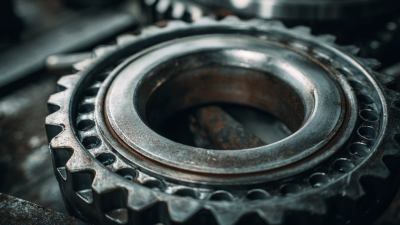How to Optimize Your Machinery with High Precision High Speed Bearings
Table of Contents
- Understanding the Importance of High Precision Bearings in Machinery
- Key Factors to Consider When Selecting High-Speed Bearings
- Techniques for Installing High Precision Bearings for Optimal Performance
- Maintenance Practices to Enhance the Longevity of High-Speed Bearings
- Troubleshooting Common Issues with High Precision Machinery Bearings
- Understanding the Role of High-Speed HCSZ Angular Contact Ball Bearings in Electric Spindle Efficiency: Insights from Industry Reports
- FAQS
- Conclusion
- Related Posts
Hey, in today’s really competitive industrial world, it’s pretty clear that optimizing machinery performance is more important than ever. High precision, high-speed bearings are absolute game-changers—they really help boost efficiency and make machinery more reliable. I recently read that the global bearing market is expected to hit around USD 93.15 billion by 2025. A big chunk of that comes from high precision bearings, mainly because they cut down friction and enable higher speeds—pretty impressive stuff. One company that’s been making waves in this space is Shandong Hangshuo Bearing Co., Ltd. They've been around since 2015 and are really pushing the envelope with research, development, and manufacturing. Their range covers everything from automotive to mining, engineering, textiles, and even agricultural machinery. By using the latest tech and advanced materials, they’re all about creating solutions that meet the rising demands for reliability and high performance, especially in super-fast applications. It’s pretty exciting to see how companies like these are shaping the future of industrial machinery.

Understanding the Importance of High Precision Bearings in Machinery
High precision bearings are honestly pretty vital when it comes to machinery—they can make a real difference in how well everything runs, how long it lasts, and how efficient it is.
 Unlike your average bearings, these high-precision ones have tighter tolerances, which means less friction and smoother operation overall. That’s especially crucial in things like aerospace, cars, or manufacturing, where you need things to spin fast and move accurately. By reducing errors in alignment and rotational behavior, they help your machines perform at their absolute best.
Unlike your average bearings, these high-precision ones have tighter tolerances, which means less friction and smoother operation overall. That’s especially crucial in things like aerospace, cars, or manufacturing, where you need things to spin fast and move accurately. By reducing errors in alignment and rotational behavior, they help your machines perform at their absolute best.
If you're looking to get the most out of your equipment with these bearings, a good starting point is choosing the right type for your specific needs. Think about things like how much weight it needs to handle, the actual operating conditions, and the speeds involved. And don’t forget—regular maintenance is key. Keep the bearings clean, well-lubricated, and check them often to prevent dirt or wear from causing problems. Also, it’s smart to keep an eye on their performance, maybe through vibration checks or thermography, so you catch any issues before they become big problems.
All in all, investing in high precision bearings can really boost your machinery’s performance. Plus, it can save you money and energy in the long run. When you understand their importance and stay on top of maintenance, your operations will not only run smoother but also stay productive, with less downtime sneaking up on you.
Key Factors to Consider When Selecting High-Speed Bearings
When you're picking out high-speed bearings for your machinery, there are a few key things you really want to keep in mind to make sure everything runs smoothly and efficiently. First up, the material the bearing’s made of is super important. Things like ceramics or really tough steels can make a big difference—they boost durability and help the bearing stay strong even when you're running things at high speeds. Plus, you should take a good look at the design of both the inner and outer rings. Getting those geometries just right can cut down on friction, carry heavier loads, and give you better overall performance.
Another thing that’s pretty critical is how you lubricate the bearing. Proper lubrication isn’t just a small detail—it actually helps reduce friction and prevent overheating, which can mess up the whole operation. For high-speed uses, it's often best to go with specialized lubricants that stay stable under tough conditions. And don’t forget about manufacturing accuracy. High-precision bearings tend to vibrate less, make less noise, and handle higher speeds and loads better. Looking at all these factors together helps manufacturers pick the right bearings, which means your machinery will last longer and work more efficiently in the long run.
Techniques for Installing High Precision Bearings for Optimal Performance
When it comes to getting machinery to perform at its best, making sure high-precision bearings are installed just right is absolutely key. Did you know that, according to the folks over at the National Institute of Standards and Technology (NIST), using precision bearings can cut down friction losses by as much as 30%? That’s a big deal—it really boosts energy efficiency and helps make manufacturing processes run smoother and use resources better. But here’s the thing: you’ve got to be super careful with the installation. Proper alignment is a must, and you want to make sure the bearings are mounted with just the right amount of preload. If they’re misaligned or not set correctly, it can cause wear and tear that might lead to early failures and higher maintenance costs down the line.
Luckily, there are some pretty cool tools—like laser alignment systems—that can make this whole process way easier. A report from the American Society of Mechanical Engineers (ASME) mentions that using these kinds of advanced tools during installation can boost accuracy to within 0.01 mm. That level of precision is crucial, especially when dealing with high-speed machinery. Also, don’t forget to follow the manufacturer’s instructions on torque settings and lubrication—it’s these little details that really help bearings last longer and perform at their best when everything’s spinning fast. Overall, taking these careful steps can make a huge difference in keeping your machinery running smoothly and efficiently.
Machinery Optimization using High Precision Bearings
This bar chart illustrates key performance metrics for machinery equipped with high precision high-speed bearings. The metrics include load capacity, operating speed, vibration level, and temperature, demonstrating how these factors play a crucial role in optimizing machinery performance.
Maintenance Practices to Enhance the Longevity of High-Speed Bearings
Keeping your high-speed bearings in good shape is pretty important if you want your machinery to last longer and run smoothly. One thing you definitely shouldn’t overlook is regular lubrication. It’s like giving your bearings a little boost—that reduces friction and helps prevent them from overheating. Just make sure you're using the lubricant recommended by the manufacturer, and follow the suggested intervals—that way, everything stays running at its best.
Another biggie is watching out for the environment where your equipment operates. Dust, dirt, and moisture—yeah, they’re sneaky and can cause bearings to wear out way faster. So, sealing up these parts or adding shields can really help keep out the bad stuff. Oh, and it’s a good idea to check on your bearings periodically, looking for any signs of wear or damage. Catching issues early on can save you a lot of headaches and money down the road.
Quick tips: Always double-check the alignment after installing or doing maintenance—that's key for smooth operation. Also, think about using vibration analysis tools sometimes. They’re pretty handy at catching imbalances or weird vibrations before things get serious. Lastly, investing in regular training for your team on proper maintenance practices can make a huge difference—they’ll know exactly how to care for those critical parts and keep everything running smoothly.
Troubleshooting Common Issues with High Precision Machinery Bearings
When it comes to high-precision machinery, dealing with common bearing issues is pretty much essential if you want your equipment to stay reliable. Those high-speed, high-precision bearings are major players—they can really make or break how well your machinery performs and how efficiently it runs. Of course, things like misalignment, crappy lubrication, or contamination can cause premature wear and, eventually, failure. The key is catching these problems early on — that way, you can avoid costly downtime and keep everything running smoothly.

Lately, with all the talk about unexpected outages popping up more often, it's become even more crucial for operators to have solid diagnostic methods in place. Using some of the latest digital tools can give you real-time data on how your bearings are doing. This means you can jump in with maintenance before things go totally sideways. Regular inspections and keeping an eye on conditions not only help extend the life of those high-precision bearings but also make your entire refinery more dependable. That’s super important in today’s competitive market where consistent production isn’t just a goal — it’s a must.
Understanding the Role of High-Speed HCSZ Angular Contact Ball Bearings in Electric Spindle Efficiency: Insights from Industry Reports
The efficiency of electric spindles is significantly influenced by the performance of high-speed High-Precision Angular Contact Ball Bearings (HCSZ). These bearings are engineered specifically for high-speed applications where light loads are common. Their design ensures minimal temperature rise and vibration, which are critical factors in maintaining spindle precision and longevity. By utilizing these bearings, manufacturers can achieve the necessary precision and stability in processes like internal surface grinding, which require exacting standards.
In industrial settings, the configuration of angular contact ball bearings as a paired support system is essential for the operational smoothness of electric spindles. This pairing enables optimal load distribution and enhances the overall rigidity of the spindle setup. The result is not just improved performance, but also extended service life of the spindle itself. As industries continue to push towards higher speeds and efficiencies, the choice of bearings becomes paramount, with high-speed HCSZ bearings standing out as an indispensable component in modern machining solutions.
FAQS
: High precision bearings are specialized components that offer tighter tolerances compared to standard bearings, reducing friction and enabling smoother operation. They are crucial in applications that require high rotational speeds and precise movement, such as aerospace, automotive, and manufacturing industries, as they enhance overall performance, efficiency, and longevity.
Key factors include the bearing's material composition (such as ceramics or high-strength steels), the design of the inner and outer rings, lubrication methods, and the precision of manufacturing tolerances. These factors collectively enhance durability, reduce friction, and improve performance in high-speed applications.
To optimize performance, it's important to select the appropriate bearing type for the specific application, ensure regular maintenance (keeping bearings clean and lubricated), and monitor performance through methods like vibration analysis or thermography to detect potential issues early.
Proper lubrication is essential as it reduces friction and prevents overheating, which can hinder performance. High-speed operations may benefit from specialized lubricants designed to maintain stability under extreme conditions, ensuring optimal bearing performance.
Proper installation techniques include ensuring accurate alignment, mounting bearings with the correct preload, and adhering to the manufacturer's specifications for torque settings. Utilizing advanced tools, such as laser alignment systems, can enhance accuracy and maintain optimal performance.
According to the National Institute of Standards and Technology (NIST), precision bearings can reduce friction losses by up to 30%, which significantly improves energy efficiency and resource utilization in manufacturing processes.
Investing in high precision bearings enhances machinery performance, contributes to energy efficiency, and results in cost savings in the long run. By improving operational productivity and reducing downtime, industries can achieve greater economic benefits.
Regular maintenance is crucial to prevent contamination and wear. Keeping bearings clean and lubricated helps ensure their longevity and performance, especially in high-speed applications where wear can lead to premature failure.
Misalignment can lead to increased wear and premature failure of the bearings, which can escalate maintenance costs. Proper alignment during installation is essential to mitigate these risks and maintain optimal operational efficiency.
Conclusion
When it comes to optimizing machinery, high-precision high-speed bearings really play a crucial role in making things run smoother and more efficiently. I mean, understanding just how important these bearings are can’t be overstated — they help cut down friction and boost accuracy across all sorts of equipment. If you’re picking out high-speed bearings, keep in mind a few key things like the material, how much weight they can handle, and their speed ratings. Getting these right means your machinery will run just the way you want it to.
And, honestly, how you install these bearings really matters. Following the right procedures can make a big difference in how well they perform. Don’t forget about regular upkeep, like lubrication and inspections — these small things can go a long way in helping the bearings last longer. Plus, knowing how to troubleshoot common issues can save you from bigger headaches down the line and keep everything operating without a hitch.
By the way, Shandong Hangshuo Bearing Co., Ltd. is a top player here, offering a wide variety of high-tech bearings tailored to suit different industries. It’s a solid reminder just how critical it is to use high-precision, high-speed bearings if you want your machines to perform at their best.
Related Posts
-

Ultimate Guide to Selecting the Right Torrington Roller Bearing for Your Application
-

Exploring Unique Alternatives for Micro Miniature Bearings in Global Sourcing
-

Top Strategies for Choosing the Best Angular Contact Ball Bearings for Your Business
-

Top Strategies for Maximizing Performance with Miniature Tapered Roller Bearings
-

Ultimate Guide to Selecting the Right Thrust Needle Roller Bearing for Your Applications
-

Ultimate Guide to Understanding 22206 Roller Bearing Specifications and Applications
Blog Tags:

